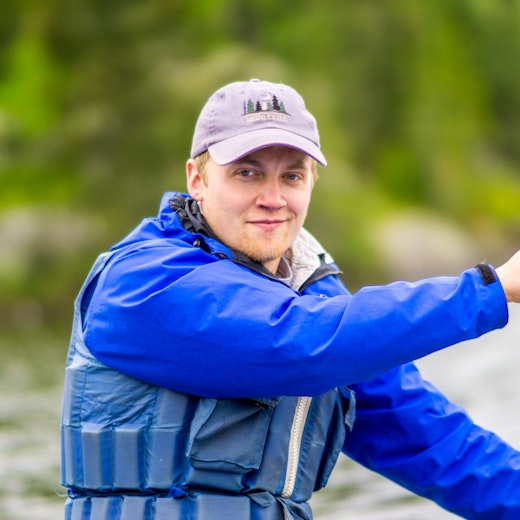Last weekend four inches of water covered the road at the narrows, turning our storied Northwoods peninsula into a laid-back beach camp. Punctual bells became lackadaisical work camp respites, alumnus Jim “Jimbo” Bergman’s deviant Fu Manchu seemed somehow socially acceptable, and John Erdmann recounted Venezuelan beach holidays body surfing, but Farm Lake was too cold to consider even a sauna plunge for all but alumnus Phil Pinc alongside thickskinned summer staff Bryan Halverson and Kyle Emman, who spent their winter dogsledding with Wintergreen.
Melting ice and snow runoff encroached on cabin 5 pylons and completely surrounded the rec hall. Floating docks required repositioning, secured with bear rope tethered to nearby trees as rising waters lifted them slowly off their cozy cribs. Silver Rapids, tamed in 1972 when rocks were dredged for the current concrete bridge, turned from a lazy river to class IV rapids. The Kawishiwi Falls, next to the Winton Hydroelectric dam, roared like Lower Basswood and Curtain Falls, dumping four times its average volume 67 vertical feet into Fall Lake, bound for Rainy River, Lake of the Woods, Hudson Bay, and eventually the Arctic Ocean.
The unusually high waters didn’t stop Jimbo and fellow airplane engineer Darrel from catching several smallmouth bass and a 38-inch northern pike in Jimbo’s new fishing boat, dubbed the Jimboat. Armed with a two-battery oversized trolling motor mounted on a handcrafted aluminum bow deck, the engineers landed several big fish casting surface lures at the flooded shoreline forests and debris from less fortunate Farm Lake residents.



The now 26-acres Camp Voyageur sits on today was over twice that size before the four-megawatt producing dam was switched on in 1929. Churchill Island (north of the chalet) was originally part of the CV peninsula. Over a hundred years ago dam construction began in the narrow channel between Garden Lake and Fall Lake. Originally lumberjacks shot logs down a flume towards the two huge sawmills at Winton. To harness hydroelectric power, the dam raised Garden, Farm, and the Kawishiwi River water level over five feet, gobbling up land– including the narrows– and transforming Farm Lake and the stretch of Kawishiwi River up past Battleship Island into a reservoir and Camp property into an island. White Iron Lake to the west wasn’t affected much.
Voyageur Camp, operated by Pat Flannegan, was founded on the island in the 1940s as a fishing outpost for older boys attending Muggs Lorber’s Camp Nebagamon in Northern Wisconsin. Flannegan built cabins one, two, three, K, the craft shop, sauna, a rec hall (Babe’s Cabin), small mess hall, and director’s cabin with lumber floated in on cedar strip rowboats. Boys came to Canoe Country for eight weeks, earning a 10-day fishing trip through the Number Lakes to Insula and Alice. They also helped clear the woods for the road across the narrows, returning the property to a peninsula after two decades of existing as an island.
The Narrows
Known for its iconic turtle crossing sign and delicious July watermelon, the water level at the aptly named narrows dictates whether we’re located on an island or peninsula. The private strait gives Voyageur a sense of separation from the rest of the world.
The geographical history of the property completed its circle when alumnus David Siegel rolled in with his campmate Phil Pinc for work camp. David’s father, Howard, was a camper at the original Voyageur Camp before it was purchased by Mim and Charlie Erdmann in 1950. He likely helped build the road across the narrows that we use daily. The water across the narrows finally began receding around May 21st, but flooding and high water levels are expected to remain for several weeks.







